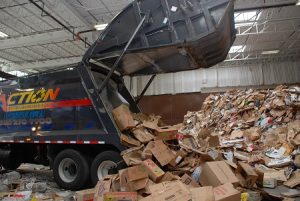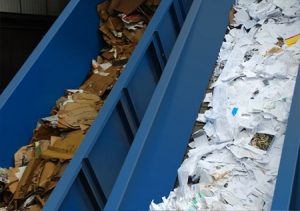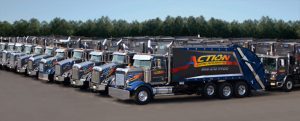From building a state-of-the-art recycling facility inside their transfer station, to operating as the largest waste company within the five boroughs of New York City, Action Carting Environmental Services has proved itself a leader in the community and a proactive partner with the city.
Founded in 1998 Action Carting Environmental Services (Teaneck, NJ) has grown from a $20 million business to a $260 million business with the help of not only some strategic business moves but also state-of-the-art facilities that boast an optical sorting system. Formerly based in Newark, NJ, John Glauda built the business on his New York City-based garbage routes, which he turned into a modest success. At the same time, Mike DiBella (one of the current owners) formed Interstate Waste Services, which was sold to a private equity group in 2007. DiBella, looking to return to the business, invested in Action Carting and continued to build the business, buying Waste Management’s commercial business in NYC and later transfer stations in the Bronx and Brooklyn from Republic.
In 2011, Action Carting built a state-of-the-art, one-of-a-kind recycling facility inside its Bronx transfer station. “We had 100,000 square foot transfer station and we were using about 20 percent, so we thought about how else can we use this facility? We decided to build an optical sorting system inside the transfer station so that we could extract recycling material out of the New York waste stream,” says Brian Giambagno, CFO of the Action Environmental Group. “It results in landfill diversion and creates a recycled product that becomes a saleable commodity.”
In 2013, Action Environmental Group (“Action”), the parent company, acquired Interstate Waste Services (“IWS”). Currently, Action’s business operates in New York City, while IWS runs from Northern New Jersey into lower New York state. Action is the largest waste company operating within New York City’s five boroughs and the largest service provider in Northern NJ. The company has approximately 800 employees working at 23 locations throughout its operating area . The company operates a fleet of approximately 350 vehicles and has three recycling facilities, the largest being in the Bronx where, using optical sorting equipment, it processes nearly 500 tons of recycling per day, primarily cardboard, paper and plastics.


Changing Market Conditions
Giambagno says that the company has experienced some positive improvements in market conditions in the past three years with increased volumes and greater diversion of solid waste into the recyclable waste stream. However, this has not come without its share of challenges. While lower fuel prices have helped the hauling business, lower commodity prices have negatively impacted the recycling business. “I’d like to see an improvement in the commodity markets; but that is beyond our control,” says Giambagno. “When commodities are at its peak, you have haulers that are both collecting and recycling, but it creates an unnatural behavior because there are haulers that really want the recycling since it is so valuable. As a result, they may give garbage services away. In 2008, the commodities market just tanked and we saw some players in the industry get impacted because their business model was only focused on the recycling side. In 2012, we started to see volumes picking up, more demand for our services and a lot less customer jumping to other haulers.” Action navigated this bumpy road well because they held true to their mission and provided good service. With a good core of long-standing customers, from Yankee stadium to the Empire State Building, the company has a premier customer base and prides themselves on the services provided. “Customer service is important to us, right down to the quality and appearance of our trucks. We train our drivers on customer service so we are taking care of customers from the street to the office,” says Giambagno.
Facing Challenges
“New York City has posed political challenges in the highly regulated industry,” says Giambagno. “We combat this with quality service, community outreach and transparency with government agencies.” Action is regulated by the Business Integrity Commission (BIC), a group that was originally called the Trade Waste Association, whose original mission was to clear out organized crime. In today’s world, the BIC imposes, among other things, a rate cap, i.e. the maximum amount that haulers can actually charge a customer. Even though it creates a lot of permitting, compliance and reporting requirements, Action maintains a very good, proactive, working relationship with the BIC.
Another challenge Action faces is the cyclicality of the commodities market. “Right now we are looking at a two-year low in the commodity market and pricing. That hurts our business and the challenge there for us is that it pushes us back to the customer level,” explains Giambagno. “We have inspectors come to our facilities to inspect bales before they get shipped; if the moisture content is too high, that bales get rejected and end up being put in the garbage and sent to a landfill. It is an education process that goes all the way back to the customer. At the end of the day, it is the haulers, the MRFs and the recycling facilities that really get impacted because they are the ones that are trying to process this recyclable material.”
In 2013, the Green Fence—a policy announced by the Chinese government—completely turned over the recycling markets so almost overnight quality standards were put into place. With the Green Fence, quality standards were put into place on what haulers were willing to accept with regards to recycled material. This put a major change on the entire industry. “Fortunately for us, our sorting system was already producing good quality product,” says Giambagno. “Now, we believe we are well-positioned to take advantage of any pick up in the marketplace.”
Improving Customer Service
Despite these challenges, the company has grown five-fold over a five year period while improving customer service, increasing market share and driving stakeholder value. “We have a number of executives who have a great vision and know the market. We are backed by private equity groups who know the industry and are very supportive. Over the years we’ve brought in new investors and asked existing investors to increase their investment levels. All that support has provided us with the resources to do several “tuck in” acquisitions over a four-year period,” says Giambagno.
He points out that customer service starts on the street—from the guy who picks up the trash to the team you have in the office. In Action’s office, there is a group of approximately eight people whose sole job is customer service; they have gone through training on the company’s services, they can take orders, offer pricing, and address any customer needs. Giambagno says they have also rolled out a customer service training program, not only for their dedicated customer service reps, but also for anyone that comes in contact with their customers. “We’ve identified 70 people in our company who come in contact with our customers and will be going through training—everything from phone etiquette to our corporate branding and how we present ourselves to customers. We also do monthly customer surveys, so not only are we constantly getting feedback on ways we can improve service, but our customers also tell us how they recognize the quality of our trucks, what our guys are wearing on the street, and comment on how they receive bills and how easy it is to work with us.”
This also extends to the communities they serve. In the Bronx, there is a program called the CEO (Center for Employment Opportunity), which gives people a second chance, such as those who were incarcerated. Action makes an effort to hire people from that organization and it has worked out very well. They also give school tours at their Bronx facility and have offered tickets to a Yankees game to schools, leagues, etc.—people that would otherwise never get a chance to see it. Action also participates in a number of programs and events throughout the city, such as Global Green, Hopes & Heros, Wounded Warrior Project, Octoberwoman and several others, so they are well known and connected with different organizations. They also go out to schools to educate students on the concept of recycling—what it means, how it works as well as communicating any news through their Twitter and Facebook accounts and e-mail blasting customers in various ways.
Safety and Training
Safety is a top priority at Action, especially when it comes to driving the routes in New York City, where all kinds of safety issues can arise, including pedestrians, parked cars and making right-hand turns. As a result, a vast majority of the trucks run at night in order to avoid the busiest parts of the day. “We do service hospitals and major office buildings, some of which require us to pick up multiple times per day, but a vast majority of our routes get dispatched around 7 pm and come back into the office around 6 am so we are not on the streets,” says Giambagno. The company makes every effort to work with the city to be proactive in order to be ahead of any changes on the routes. “We know where the construction is, where the street closings are, what days are the parades, where we can put containers to service the customer. Everything is permitted so we are constantly checking and getting permits on where you can service and where you can’t in the city.”
Action also has a risk management group that includes the Chief Compliance Officer, a Risk Manager and a Safety Director. Giambagno stresses that a safety strategy starts when you look at your insurance claims and get down to the root cause of them (hurt backs, cuts, etc). The company’s New York city trucks have one driver and two helpers. Drivers and helpers are trained on how to properly manage the waste on the street, how to drive the truck, what to look out for when driving and right-hand turns (where a majority of the accidents occur). “In one of our existing facilities, we are in the process of building a training facility for our employees and then putting a curriculum in place for all of our drivers and helpers who will go through a structured safety training program.”
The company also provides safety and new hire videos and holds weekly and monthly safety meetings. Giambagno believes that a good safety strategy starts with their risk management group, compliance team and safety coordinator who make sure that new hires go through a safety program before they go anywhere near a truck. That training continues throughout employees’ careers with constant reminders of different protocols with regards to the street and in the truck. “We spend a lot of time and effort on training and our drivers. We have camera systems in our trucks, which we use for training purposes so we can see what is going on in the front, back and inside the truck. If something does happen, we can pull the footage to see what the driver was doing and use it as training for future reference. We are very proactive in that regard.”
In fact, one of IWS’s drivers was named as one of the Drivers of the Year by the National Solid waste Association and will be receiving the award at the Waste Expo (see Driver of the Year 2015 sidebar). “It is a major reflection on our safety and training programs,” says Giambagno.

Towards the Future
Action is always searching for: 1) growth opportunities within their market areas, 2) methods to drive operational efficiencies and 3) continuous improvements in their recycling processes. “We take pride in our fleet and we try to keep the average age of our trucks at seven years and younger. For those trucks that hit the seven-year mark, we use them for parts, sell them back into the market, or just use them as spares so its not running every day, but just in case something is broken down, or you need to take the trucks off the road for a period of time for maintenance, it is available. We are also looking at an investment in onboard computing, so we know where every truck is on the road, where they’ve been, how many miles they’ve driven, all of the diagnostics. We believe that will lead to better compliance, safety, customer service and efficiency for the company. By the end of the summer we will make a decision on what type of system to implement.”
Because they are a Northeast-based company, Action Carting will continue to focus on the areas that they know; however, they are considering an expansion into new geographic territories. Looking at their five-year plan, a few things are being evaluated and may be on the horizon, including processing food waste collected from New York City, composting, digestive systems, producing energy and fuel from waste (which they can use to run a facility or use in trucks). They are also starting to evaluate CNG. “We know we need to go in that direction especially with New York’s new emissions standards,” says Giambagno. “By 2020 fleets have to meet certain emission standards and we have a roadmap as to when our fleet is going to meet those standards and those of the city.”
For more information, contact Brian Giambagno, Chief Financial Officer of the Action Environmental Group, Inc. at (973) 286-7008, via e-mail at [email protected] or visit www.ActionEnvironmentalGroup.com.
Sidebar
Driver of the Year 2015
The National Waste & Recycling Association (NWRA) is the trade association representing private-sector U.S. waste and recycling companies who operate in all 50 states. They provide leadership, advocacy, research, education and safety expertise to promote a climate where members prosper and provide safe, economically sustainable and environmentally sound services. Promoting safety is one of their major objectives and in doing so they recognize annually, safe drivers through their Driver of the Year Award. There are 10 different categories—Large Resi, Commercial, & Industrial, Regional Resi, Commercial & Industrial, Medium, Small, Municipal Large & Small. The award is presented at the annual Association meeting held in June.
This year, The Action Environmental Group family is pleased to have two of their 272 drivers qualify for the finals. Action’s Jose Diaz, a Roll Off driver based in Newark was a runner-up in their category, and IWS’s Alan Baltimore (above) from Chester was selected as the Driver of the Year in the category of medium size companies. Congratulations to both!
Baltimore will be completing his 30th year of driving this coming December. He presently drives a packer truck in Orange County, NY for IWS, having previously serviced the Village of Blooming Grove, who provided a glowing recommendation to the Association. Baltimore’s supervisors say he’s an excellent employee. Giambagno agrees with their assessment, “When something is not right, he takes responsibility.” Below are a few fun facts about Baltimore and his inspirations.
- Did you have a hero? My father, Jim Baltimore.
- What have you done in life to live what your hero taught you? Always maintain a good work ethic.
- Why have you been successful? I try to keep a positive attitude.
- Why are you where you are today? Because of support from my family with the long hours that we keep here.
- Who, specifically, would you single out as the most important person in your life/your biggest cheerleader? My daughter, Tinan Baltimore.
- What kind of activities do you like to do outside of work? Fishing, spending time with friends.
- Why is this a valuable industry to work in? Job security—there’s always going to be garbage.
- What makes you proud of your work? Helping the customers and keeping Orange County clean.
